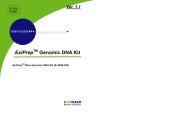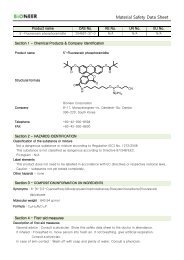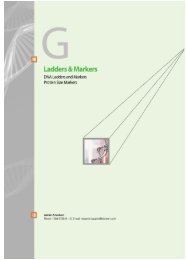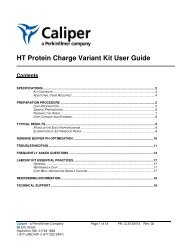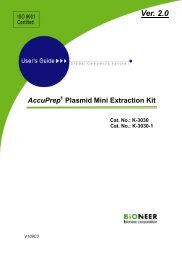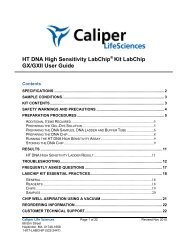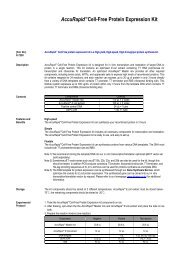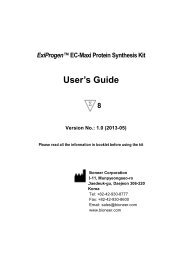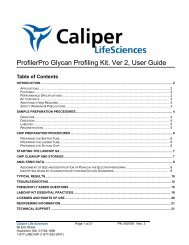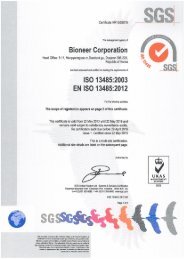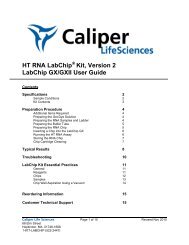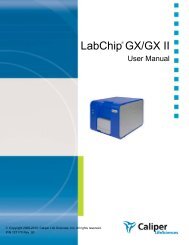MSDS - Bioneer
MSDS - Bioneer
MSDS - Bioneer
Create successful ePaper yourself
Turn your PDF publications into a flip-book with our unique Google optimized e-Paper software.
Material Safety Data SheetVersion No.: 1.0(Revision 2012-11-30)Atom 18 Spacer Phosphoramidite1. Chemical Products & Company IdentificationProduct name : Atom 18 Spacer PhosphoramiditeDMTOOOOOOOStructural formula :Company : <strong>Bioneer</strong> Corporation8-11, Munpyeongseo-ro, Daedeok-Gu, Daejon 306-220, South KoreaTelephone : +82-42-930-8594FAX : +82-42-930-8600P ON(iPr) 2CN2. HAZARDS IDENTIFICATIONClassification of the substance or mixture :Not a dangerous substance or mixture according to Regulation (EC) No. 1272/2008This substance is not classified as dangerous according to Directive 67/548/EEC.Pictogram : N/ALabel elements :This product does not need to be labelled in accordance with EC directives or respective national laws.Caution : Substance not yet tested completelyOther hazards : none3. COMPOSITION/INFORMATION ON INGREDIENTSSynonyms : 18-O-Dimethoxytritylhexaethyleneglycol,1-[(2-cyanoethyl)- (N,N-diisopropyl)]-phosphoramiditeMolecular weight : 784.93 g/molFormula : C 42H 61N 2O 10P4. First-aid measuresDescription of first aid measuresGeneral advice : Consult a physician. Show this safety data sheet to the doctor in attendance.If inhaled : If breathed in, move person into fresh air. If not breathing, give artificial respiration.Consult a physician.In case of skin contact : Wash off with soap and plenty of water. Consult a physician.In case of eye contact : Flush eyes with water as a precaution. Consult a physician.If swallowed : Never give anything by mouth to an unconscious person. Rinse mouth with water.Consult a physician.Most important symptoms and effects, both acute and delayed.1www.bioneer.comBQ-042-101-06Revision : 0(2012-11-29)
To the best of our knowledge, the chemical, physical, and toxicological propertied have not been thoroughlyinvestigated.Indication of any immediate medical attention and special treatment needed : N/A5. Fire fighting measuresSuitable extinguishing mediaUse water spray, alcohol-resistant foam, dry chemical or carbon dioxide.Special hazards arising from the substance or mixture : N/AAdvice for fire fighters : Wear self contained breathing apparatus for firefighting if necessary.Further information : N/A6. Accidental release measuresPersonal precautions, protective equipment and emergency proceduresAvoid breathing vapors, mist or gas. Ensure adequate ventilation.Environmental precautionsPrevent further leakage or spillage if safe to do so. Do not let product enter drains. Discharge into the environmentmust be avoided.Methods and materials for containment and cleaning upPick up and arrange disposal without creation dust. Sweep up and shovel. Keep in suitable, closedcontainers for disposal7. Handling and storagePrecautions for safe handlingAvoid all direct contact and wear protective clothing, respirator, goggles, gloves.Provide appropriate exhaust ventilation at places where dust is formed.Conditions for safe storageStore in a cool place. Keep container tightly closed in a dry and well-ventilated place.Recommended storage temperature : below -10 °C8. Exposure controls/personal protectionControl parameters : Components with workplace control parametersExposure controlsAppropriate engineering controls : Handle in accordance with good industrial hygiene and safety practice.Wash hands before breaks and at the end of workday.Personal protective equipmentEye/Face protection : Use equipment for eye protection tested and approved under appropriate governmentstandards such as NIOSH(US) or EN 166(EU)Skin protection : Handle with gloves. Gloves must be inspected prior to use. Use proper glove removal (withouttouching glove’s outer surface) to avoid skin contact with this product. Dispose ofcontaminated gloves after use in accordance with applicable laws and good laboratorypractices. Wash and dry hands. The selected protective gloves have to satisfy thespecifications of EU Directive 89/686/EEC and the standard EN 374 derived from it.Body protection : Choose body protection in relation to its type, to the concentration and amount of dangeroussubstances, and to the specific work-place. The type of protective equipment must be2www.bioneer.comBQ-042-101-06Revision : 0(2012-11-29)
selected according to the concentration and amount of the dangerous substance at thespecific work-place.Respiratory protection : Where protection from nuisance levels of dusts are desired, use type N95 (US) or typeP1(EN 143) dust masks. Use respirators and components tested and approved underappropriate government standards such as NIOSH(US) or CEN (EU).9. Physical and chemical propertiesInformation on basic physical and chemical propertiesAppearance : oilColor : Colorless to light yellowOdor : N/ApH : N/AMelting point/Freezing point : N/ABoiling point : N/AFlash point : N/AEvaporation rate : N/AFlammability(solid, gas) : N/AUpper/Lower flammability or explosive limits : N/AVapor pressure/density : N/ARelative density : N/AWater solubility : non-solublePartition coefficient(n-octanol/water) : N/AAutoignition temperature : N/ADecomposition temperature : N/AViscosity : N/AExplosive properties : N/AOxidizing properties : N/A10. Stability and reactivityChemical stabilityStable under recommended storage conditions.Conditions to avoidno data availableMaterials to avoidStrong oxidizing agentsHazardous decomposition productsHazardous decomposition products formed under fire conditions. - Carbon oxides(COx), nitrogen oxides (NOx),Oxides of phosphorus(PxOy)11. Toxicological informationAcute toxicity : N/ASkin corrosion/irritation : N/ASerious eye damage/eye irritation : N/ARespiratory or skin sensitization : N/A3www.bioneer.comBQ-042-101-06Revision : 0(2012-11-29)



